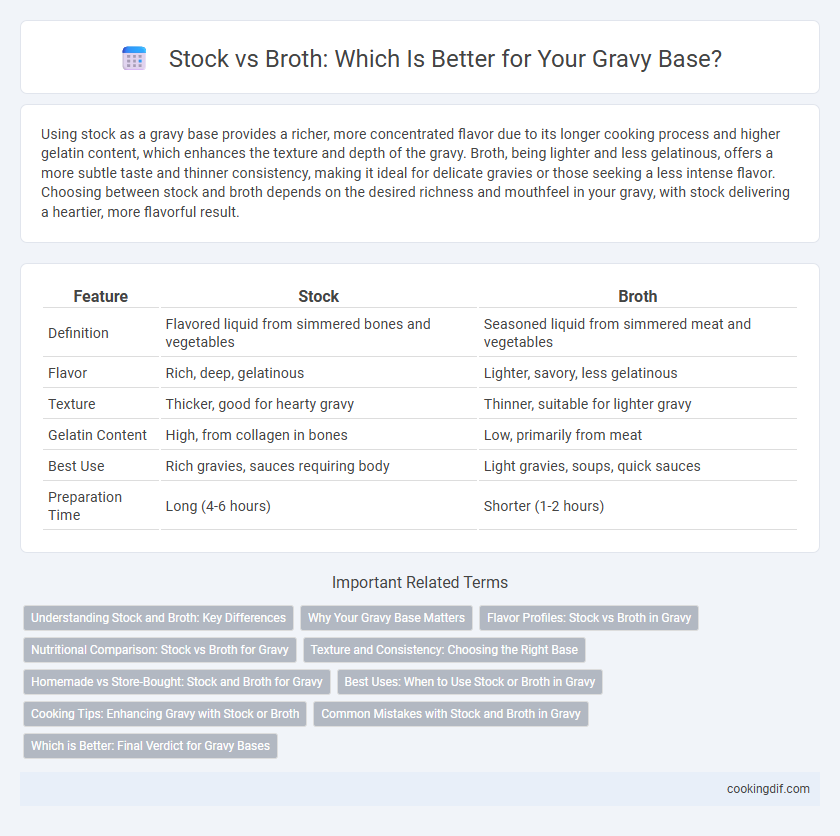Using stock as a gravy base provides a richer, more concentrated flavor due to its longer cooking process and higher gelatin content, which enhances the texture and depth of the gravy. Broth, being lighter and less gelatinous, offers a more subtle taste and thinner consistency, making it ideal for delicate gravies or those seeking a less intense flavor. Choosing between stock and broth depends on the desired richness and mouthfeel in your gravy, with stock delivering a heartier, more flavorful result.
Table of Comparison
| Feature | Stock | Broth |
|---|---|---|
| Definition | Flavored liquid from simmered bones and vegetables | Seasoned liquid from simmered meat and vegetables |
| Flavor | Rich, deep, gelatinous | Lighter, savory, less gelatinous |
| Texture | Thicker, good for hearty gravy | Thinner, suitable for lighter gravy |
| Gelatin Content | High, from collagen in bones | Low, primarily from meat |
| Best Use | Rich gravies, sauces requiring body | Light gravies, soups, quick sauces |
| Preparation Time | Long (4-6 hours) | Shorter (1-2 hours) |
Understanding Stock and Broth: Key Differences
Stock and broth serve as foundational liquids for gravy, but their distinctions affect flavor and texture significantly. Stock is made by simmering bones with connective tissue, creating a rich, gelatinous base that adds depth and body to gravy, while broth is typically prepared from meat, vegetables, and seasoning, resulting in a lighter, more delicate flavor. Understanding these key differences helps in choosing the ideal base to enhance the desired consistency and taste of any gravy recipe.
Why Your Gravy Base Matters
Choosing the right base between stock and broth significantly impacts the depth and richness of your gravy. Stock, simmered with bones and vegetables for hours, delivers a robust, gelatinous texture that enhances the gravy's mouthfeel and flavor complexity. Broth, often lighter and made primarily from meat, provides a subtler taste, making it suitable for delicate gravies but less effective in achieving the hearty consistency prized in traditional recipes.
Flavor Profiles: Stock vs Broth in Gravy
Stock offers a rich, concentrated flavor with gelatin extracted from simmering bones, providing a deep umami base ideal for gravy. Broth, made primarily from meat and vegetables, delivers a lighter, more delicate taste that can make gravy less intense but brighter in flavor. Using stock enhances the savory complexity and body of gravy, while broth contributes a subtle, refreshing element.
Nutritional Comparison: Stock vs Broth for Gravy
Stock offers a richer nutrient profile than broth, containing higher levels of collagen, gelatin, and minerals extracted from simmered bones, which contribute to a thicker, more flavorful gravy base. Broth, typically made from meat, vegetables, and seasoning, provides a lighter, more protein-focused option but generally lacks the dense mineral content found in stock. Choosing stock for gravy enhances calcium, magnesium, and amino acid content, supporting robust flavor development and nutritional benefits.
Texture and Consistency: Choosing the Right Base
Stock provides a richer, more gelatinous texture for gravy due to its higher collagen content, resulting from simmering bones and connective tissues. Broth, made primarily from meat and vegetables, offers a lighter consistency that yields a thinner, less viscous gravy. For a smooth, velvety gravy with a full-bodied mouthfeel, stock is the ideal base, while broth suits recipes requiring a more delicate sauce.
Homemade vs Store-Bought: Stock and Broth for Gravy
Homemade stock offers a richer, more complex flavor profile for gravy compared to store-bought broth, thanks to slow simmering of bones and vegetables that extract deeper umami tastes. Store-bought broth provides convenience and consistency but often contains added sodium and preservatives that can affect the gravy's natural taste. Opting for homemade stock enhances the gravy's texture and depth, making it the preferred base for culinary quality and flavor customization.
Best Uses: When to Use Stock or Broth in Gravy
Use stock as the base for rich, flavorful gravy due to its concentrated taste derived from simmering bones, which imparts depth and body ideal for roasted meats and hearty dishes. Broth, lighter and clearer, suits gravies for poultry or vegetables where a delicate, subtle flavor enhances without overpowering the dish. Choosing between stock and broth depends on desired richness and the dish's intensity, with stock preferred for robust gravies and broth for lighter, more nuanced sauces.
Cooking Tips: Enhancing Gravy with Stock or Broth
Using stock as a gravy base amplifies flavor depth due to its slow-simmered bones and aromatics, providing a richer, more robust taste compared to broth. Incorporate homemade or high-quality store-bought stock, reducing it gently to intensify savory notes before thickening for a velvety texture. Broth, being lighter and more delicate, works well for quick gravies but benefits from seasoning adjustments and simmering to extract maximum flavor.
Common Mistakes with Stock and Broth in Gravy
Using broth instead of stock in gravy often results in a thinner texture and less rich flavor due to broth's lower collagen content. Many cooks mistakenly overlook the importance of simmering time, as stock requires extended cooking to release gelatin, which thickens and enhances gravy. Relying on store-bought broth can also introduce excess salt and artificial flavors, compromising the savory depth essential for a quality gravy base.
Which is Better: Final Verdict for Gravy Bases
Stock provides a richer, more concentrated flavor and thicker texture, making it the preferred base for robust gravies. Broth offers a lighter, more subtle taste that works well for delicate dishes but may require additional seasoning for depth. For gravies that demand boldness and body, stock is the superior choice.
Stock vs Broth for gravy base Infographic

 cookingdif.com
cookingdif.com